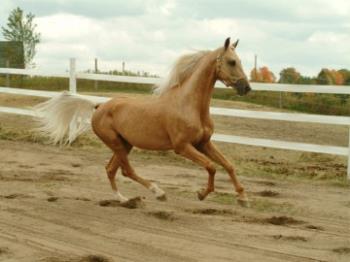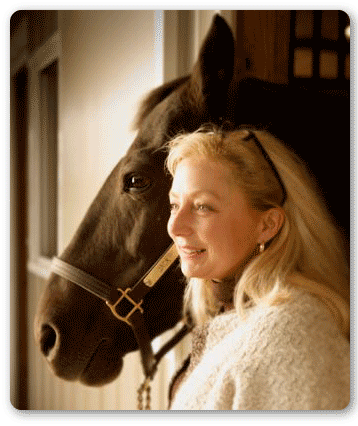Fencing and Handling Stallions

Stallions have been romanticized through the ages in literature and popular culture, from Bucephalus and the Black Stallion to The Lone Ranger's Silver and the animated Spirit, Stallion of the Cimarron. The knight in shining armor always arrives astride a white stallion to rescue the fair maiden. A stallion is often used to showcase his breed in books, and stallions are featured front and center in parades of breeds. Despite their somewhat mystical aura, stallions are horses, too, not so different from the everyday Equus caballus. However, because of their nature, they can warrant special handling that goes a step beyond the average mare or gelding.
Without a doubt, any male horse kept intact for breeding must be exceptional and worthy of reproducing. Once that is established, it is important to prepare your farm for his comfort and well being. ''If you don't know how to handle a stallion, don't do it,'' says Dave Williams, a professional team roper who's also handled Standardbred stallions. If you are unsure of proper stallion handling procedures, it is most likely best left to professionals. Putting your stud in a stallion facility can have many benefits. Some promotional costs, such as photography rates, can be shared with other stallion owners. When checking out a facility, make sure the staff is familiar with stallion handling and is willing to take the extra care necessary to keep him well.
If you are keeping your stallion at home, and he is the only stud on the farm, it is important to make arrangements on your farm for him. Put his turnout area where he can easily observe farm activity so he doesn't get bored, suggests Heather Maxson of Michigan. She and her father stand their Quarter Horse Stallion, Tradition Copy, on their family farm. Tradition Copy's stall is set at the end of the barn where he can look out and see other horses so he can still feel like part of the herd. His stall is a bit larger than average at 12'x16', which is typical of most stallion stalls. The wall up front by his feed area is solid so that he has privacy when he eats, and his teasing area is a grilled stall partition. The bars are close enough and strong enough to prevent him from getting hung up in case of emergency. It is also a good idea to have the wall tall enough, a minimum eight feet, to prevent a mare or stallion from trying to climb it.
As far as fencing for stallions, Maxson pointed out that Michigan has a state law stating that stallion fencing must be at least 6' tall. Check with your local extension agency for ordinances governing stallion containment in your area. Just like people, horses' personalities can vary. The same is true with stallions. Some are stereotypical, aggressive and almost uncontrollable. Others are laid back and quite gentlemanly. Wherever your stallion fits on the scale, proper containment is not a responsibility to be taken lightly.
Things to consider:
- Check for fence height restrictions in your area. You'll want to use the highest, strongest fence allowable for stallions.
- Investigate those fencing materials that have higher break strength. Among these are coated wire and flexible polyethylene (plastic) rails bonded to high tensile wires.
- Using electric with your fence system will enhance safety.
- When possible, pasture mares separately. Aisles should be 12' or more.
Make sure the aisle will accommodate mowers, vehicle and trailers.
Remember, you're not only keeping your stallion in, you're fencing out any horse that may get free and want to challenge your horse. Just as there are special considerations for keeping stallions on the farm, there are also special considerations when taking stallions away from the farm. Showing stallions is a great way to promote them, but keep a few things in mind when doing so. When taking stallions to a show, be sure to notify show management that your horse is a stallion. Susan Hutchison, 1992 AGA Rider of the Year and five-time participant in the World Cup Finals, highly recommends stabling stallions next to geldings, if possible.
Jeannie Strain, of Strains' Thoroughbreds in Swanton, Ohio, points out that at a racetrack, you will likely not have a choice as to stabling arrangements, and there isn't much difference in the way stallions are accommodated compared to mares and geldings. Sometimes scent-blockers are put on stallions'; noses as a precautionary measure. Pony horses may be outfitted in protective gear to prevent them from getting nipped. Pony horses are those that lead the racehorses onto the track; a good pony horse is very valuable and extra care is taken for his protection.
Manners are so important for any horse, and especially for stallions. Whether you have your stud at home, at a show, or at a racetrack, he must be well behaved at all times. Good manners help protect a horse from harm and improve his desirability to mare owners. Good manners are associated with a pleasant personality, and that is a trait mare owners want in their babies.
Denise Ley, of Ley's Long-Ears, says manners are especially important when handling jacks, male, intact donkeys. Jacks can be more aggressive during breeding than stallions, and it is not unusual for a jack to turn on his handler without warning. It's a good idea to carry a whip when handling jacks during breeding. Denise has three jacks and three, registered miniature horse stallions that she runs together. She says that works in her situation because they've all been raised together and that she would never introduce a strange stallion to the herd. She's also very firm in her discipline and they have plenty of room to move about. So far, three of them, two stallions and one jack, have been pulled from the herd for breeding and then successfully returned. The ''boys'' are pastured adjacent to the mares and jennies, and electric fencing keeps everybody back.
This is usually not the case when there are multiple studs and mares on one farm. Turn the mares out at different times or on the opposite side of the farm. If there is more than one stallion and they are turned out at the same time, it is ideal to keep them one per paddock and keep a corral between them, says Susan Hutchinson. Avoiding a shared fence line between horses can go a long way to preventing altercations and injury. Keep in mind how sensitive each stallion is, Susan advises. A more aggressive approach needed with one stallion may not be appropriate with another. Check with past handlers to see what works best with each stallion.
A fine stallion is sure to be the pride of any barn. A stallion owner is bound to get a little misty as those new babies arrive and start displaying their father's good looks and talents. With a bit of preparation and consistent handling techniques, your stallion will be a happy, healthy, and comfortable boy. He'll be ready to run free in a field, turning and spooking, creating the incomparable sound of thundering hooves.
 Debbie has over 45 years experience with horses and equine-related businesses. She has owned, trained, boarded horses and run stables at various times in her career. She is a certified fence installer, has given balanced riding lessons, and has shown horses in Western, Western Pleasure, Trail, English, Hunter/Jumper, Fox Hunting, Hunter Trials, Dressage and driving classes. Debbie has been involved in foaling, and just about every aspect of horse ownership possible, and she welcomes your questions and comments. If you are interested in using any articles by Debbie, please send her an email.
Debbie has over 45 years experience with horses and equine-related businesses. She has owned, trained, boarded horses and run stables at various times in her career. She is a certified fence installer, has given balanced riding lessons, and has shown horses in Western, Western Pleasure, Trail, English, Hunter/Jumper, Fox Hunting, Hunter Trials, Dressage and driving classes. Debbie has been involved in foaling, and just about every aspect of horse ownership possible, and she welcomes your questions and comments. If you are interested in using any articles by Debbie, please send her an email.
RAMM Fence Systems, Inc. makes every effort to provide reliable and useful information on horse health, care and products. The statements made on this website are based on years of experience with horses, however, they are based on generalized situations and should not replace diagnosis or treatment by a veterinarian or consultation by a professional. RAMM Fence Systems, Inc. does not assume any legal responsibility. Readers should always consult qualified health care providers for specific diagnosis and treatment.
